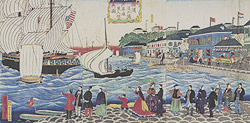Hokkaido Toyako Summit
Venues

residences from Yokohama Wharf
The cultural climate developed around the Port of Yokohama as a window of exchange with the world created a unique Yokohama style that is full of curiosity and warmly accepting of new things. Since the opening of the port, the people of Yokohama have learned a huge variety of knowledge and technology from many visitors from abroad. The food and drink menu alone spans everything from western vegetables, bread, milk and ice cream to beer and cocktails. And while there were many things that spread in their original from Yokohama to the rest of Japan, there were also many that were modified in Yokohama to suit Japanese use or taste, as with the beef dish sukiyaki.
Within the city there is a long list of notable sites such as Sankeien, a pure Japanese garden that has been designated as a national beauty spot; the Yamashita Kannai district, which is home to many historic buildings that date back to the time of the opening of the port; one of the world's largest-scale Chinatowns, which attracts around 20 million visitors each year; and Minato-Mirai 21, an ultramodern district of tall buildings that stand facing the bay. In each of these places, as well as enjoying great food, visitors can soak up a distinct atmosphere.
The integration of the past and future, and of Japanese and foreign cultures-that's Yokohama's biggest attraction.